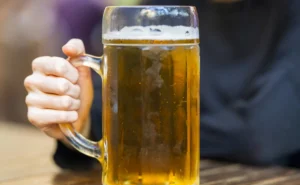The age-old question that has intrigued beer enthusiasts for centuries: Why does beer taste so good? As we lift our glasses to savor that crisp, hoppy goodness, there’s a complex symphony of flavors and aromas at play.
Join me on a journey into the delightful world of beer, exploring the science, craftsmanship, and artistry that contribute to the unparalleled pleasure of that first sip. So, why does beer taste so good? Let’s dive into the delightful alchemy that transforms malt, hops, yeast, and water into a beverage that transcends its simple ingredients.
Why does beer taste so good?
The taste of beer is subjective and can vary from person to person, but there are several factors that contribute to the overall enjoyment of beer:
- Ingredients: The basic ingredients of beer are water, malted barley, hops, and yeast. The combination of these ingredients, along with variations in the brewing process, can result in a wide range of flavors, aromas, and textures.
- Complexity: Beer is a complex beverage with a variety of flavors and aromas. Different styles of beer offer unique profiles, ranging from the malty sweetness of a stout to the hoppy bitterness of an IPA. The complexity allows for a diverse range of tastes that can appeal to different preferences.
- Carbonation: The carbonation in beer provides a fizzy and refreshing quality, enhancing the drinking experience. The bubbles can contribute to the mouthfeel and play a role in how the flavors are perceived.
- Alcohol Content: The alcohol content in beer can influence its taste and overall drinking experience. The warming sensation of alcohol, combined with the other flavors, can contribute to the enjoyment for some individuals.
- Temperature: The temperature at which beer is served can greatly impact its taste. Different styles of beer may be best enjoyed at specific temperatures, and serving beer at the appropriate temperature can enhance its flavors and aromas.
- Pairing with Food: Beer can complement a wide variety of foods. The interaction between the flavors of the beer and the food can create a harmonious experience, making both the beer and the food taste better together.
- Cultural and Social Factors: The social and cultural context in which beer is consumed can also influence its perceived taste. Enjoying a beer with friends, in a relaxed setting, or during a celebration can contribute to the overall positive experience.
Ultimately, the appeal of beer is a combination of sensory experiences, personal preferences, and cultural factors. Different people may appreciate different aspects of beer, making it a versatile and enjoyable beverage for many.
Importance of understanding why beer tastes good
Understanding why beer tastes good is important for several reasons:
- Appreciation: Understanding the factors that contribute to the taste of beer allows individuals to appreciate its complexity and diversity. It enables people to discern different flavors, aromas, and characteristics in various beer styles.
- Quality Assessment: For brewers and enthusiasts alike, knowing why beer tastes good helps in assessing the quality of beer. It allows for the identification of off-flavors or inconsistencies in the brewing process, ensuring higher-quality products.
- Brewing Process: Brewers can utilize this knowledge to refine their brewing techniques, experiment with ingredients, and manipulate variables to create unique and appealing flavors that cater to different tastes.
- Consumer Experience: When consumers understand why they enjoy a particular beer, it helps them make informed choices when selecting new beers to try. They can explore different styles based on their preferences and better appreciate the nuances of each.
- Pairing with Food: Understanding the flavors in beer can aid in pairing it with food, enhancing the dining experience by creating complementary flavor profiles between the beer and the dish.
- Cultural and Social Enjoyment: It adds depth to the social and cultural aspects of beer consumption. Sharing knowledge about beer enhances conversations and experiences among friends, fostering a deeper appreciation for the beverage.
- Industry Growth: For the beer industry, understanding why beer tastes good helps in innovating new products, meeting consumer demands, and maintaining a competitive edge in the market.
Overall, comprehending the elements that contribute to the enjoyment of beer enriches the entire beer-drinking experience, from production to consumption, for both enthusiasts and those involved in its production and distribution.
Beer Styles and Flavor Profiles
Beer comes in a wide variety of styles, each with its own distinct flavor profile. The flavors in beer are influenced by factors such as the ingredients used (malt, hops, yeast, and water), the brewing process, and any additional flavorings. Here are some common beer styles and their typical flavor profiles:
- Pale Ale:
- Flavor Profile: Balanced malt sweetness with a noticeable hop bitterness. Citrus, floral, or piney hop flavors are common. Pale ales can range from light to amber in color.
- India Pale Ale (IPA):
- Flavor Profile: Higher hop bitterness and aroma compared to pale ales. Citrus, pine, and floral hop flavors are prominent. IPAs can vary from traditional (English) to more hop-forward American styles.
- Stout:
- Flavor Profile: Dark, rich, and often roasted malt flavors. Chocolate, coffee, and caramel notes are common. Stouts can range from sweet to dry and from lower to higher alcohol content.
- Porter:
- Flavor Profile: Similar to stouts but generally lighter in body and alcohol. Roasted malt, chocolate, and caramel flavors are typical. Porters often have a good balance between malt sweetness and bitterness.
- Wheat Beer (Hefeweizen):
- Flavor Profile: Light and refreshing with a significant wheat malt character. Banana and clove esters from the yeast are common. Hefeweizens are often unfiltered, resulting in a cloudy appearance.
- Pilsner:
- Flavor Profile: Crisp and clean with a noticeable hop bitterness. Pilsners are pale lagers with a malt backbone and a dry finish. They are known for their refreshing qualities.
- Saison:
- Flavor Profile: Rustic and fruity with a spicy yeast character. Saisons often have a complex flavor profile with notes of citrus, pepper, and earthiness. They can be slightly tart and effervescent.
- Belgian Dubbel/Tripel/Quadrupel:
- Flavor Profile: Belgian yeast character is prominent, providing fruity and spicy notes. Dubbels are maltier, Tripels are strong and fruity, while Quadrupels are rich and complex with higher alcohol content.
- Barleywine:
- Flavor Profile: Rich and malty with high alcohol content. Barleywines can be either English-style (more malt-focused) or American-style (more hop-forward). They often have notes of toffee, caramel, and dark fruit.
- Sour Beers (Gose, Berliner Weisse, Lambic):
- Flavor Profile: Tart and sour with varying degrees of acidity. Gose may have added salt, Berliner Weisse is often light and refreshing, while Lambics can be complex and funky with wild yeast and bacteria.
These are just a few examples, and there are many more beer styles, each with its unique flavor characteristics. Exploring different styles can be an enjoyable way to discover the diversity of flavors that the world of beer has to offer.
Pairing Beer with Food
Pairing beer with food can enhance the overall dining experience by creating complementary flavor profiles. Here are some general guidelines for pairing beer with food:
- Light Beers with Lighter Foods:
- Examples: Pilsners, wheat beers, light lagers.
- Pairings: Salads, seafood, grilled chicken, sushi.
- Hoppy Beers with Spicy Foods:
- Examples: India Pale Ales (IPAs), pale ales.
- Pairings: Spicy curries, Mexican dishes, spicy wings.
- Malty Beers with Rich and Savory Dishes:
- Examples: Amber ales, brown ales, bocks.
- Pairings: Roast meats, burgers, stews, BBQ.
- Dark Beers with Robust Flavors:
- Examples: Stouts, porters, dark ales.
- Pairings: Chocolate desserts, smoked meats, hearty stews.
- Wheat Beers with Light and Citrusy Flavors:
- Examples: Hefeweizens, witbiers.
- Pairings: Citrus salads, seafood, light cheeses.
- Belgian Beers with Complex and Spicy Foods:
- Examples: Belgian ales, saisons, tripels.
- Pairings: Spicy sausages, Thai dishes, tangy cheeses.
- Sour Beers with Tangy or Fatty Foods:
- Examples: Gose, Berliner Weisse, sour ales.
- Pairings: Oysters, ceviche, creamy cheeses.
- Barleywines with Rich and Sweet Desserts:
- Examples: English barleywines, American barleywines.
- Pairings: Bread pudding, caramel desserts, blue cheese.
- Lighter Beers with Lighter Cheeses:
- Examples: Pilsners, wheat beers.
- Pairings: Fresh cheeses, goat cheese, mozzarella.
- Pair According to Regional Cuisine:
- Match beers with the traditional beverages of the cuisine you’re enjoying. For example, pair a lager with Mexican dishes or a Belgian ale with Belgian cuisine.
Remember, these are general guidelines, and personal preferences play a significant role in beer and food pairings. It’s also helpful to consider the intensity of flavors in both the beer and the food. Experimenting with different combinations can lead to delightful discoveries, so don’t hesitate to try new pairings and find what works best for your palate.
Impact of serving temperature on beer taste
The serving temperature of beer has a significant impact on its taste and overall drinking experience. Different beer styles are best enjoyed at specific temperatures, and serving a beer too cold or too warm can mask or exaggerate certain flavors. Here’s a general guide to the impact of serving temperature on beer taste:
- Too Cold (Very Cold):
- Impact: Serving beer at very cold temperatures can numb the taste buds, reducing the beer’s aroma and flavor perception.
- Styles Affected: Light lagers, pilsners, and some light ales may lose subtle nuances when served too cold.
- Recommendation: While these styles are generally served colder, extreme cold temperatures should be avoided to allow the flavors to develop.
- Chilled (Cellar Temperature):
- Impact: Serving beer at a chilled, but not too cold, temperature allows for a fuller flavor experience. The malt and hop characteristics are more noticeable.
- Styles Affected: Many ales, including pale ales, IPAs, stouts, porters, and Belgian ales, are often best enjoyed at cellar temperature (around 45-55°F or 7-13°C).
- Recommendation: This temperature range is suitable for a wide variety of beer styles, allowing the drinker to appreciate the complexity of flavors.
- Cool (Refrigerator Temperature):
- Impact: Slightly cooler temperatures enhance the crispness of certain styles, particularly lagers, without dulling the flavors.
- Styles Affected: Light lagers, pilsners, and some ales benefit from being served cool (around 38-45°F or 3-7°C).
- Recommendation: This range is suitable for refreshing beers and can enhance their drinkability.
- Warmer (Cellar Temperature to Room Temperature):
- Impact: As beer warms, more complex flavors become noticeable. Aromas and malt characteristics are more pronounced.
- Styles Affected: Strong ales, barleywines, Belgian strong ales, and certain stouts and porters can benefit from being served warmer (55-60°F or 13-16°C).
- Recommendation: Allow these styles to warm slightly in the glass to fully appreciate their depth and complexity.
- Too Warm:
- Impact: Excessive warmth can lead to an unpleasant experience, as some beers may become overly sweet or exhibit off-flavors.
- Styles Affected: Most styles are not intended to be served too warm, as it can negatively impact the balance of flavors.
- Recommendation: It’s generally advisable to avoid serving beer at temperatures above the recommended range for a particular style.



